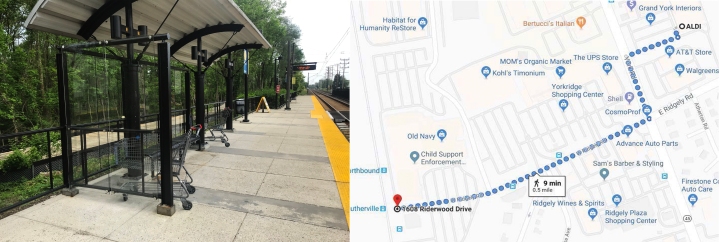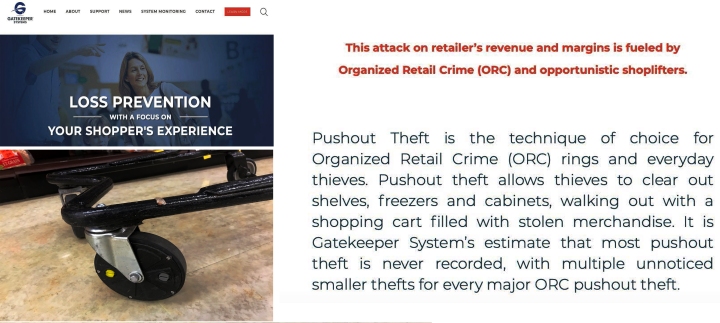By Sachin Hebbar.
Abandoned Walmart shopping carts are a common sight at the bus stop at the intersection of Prince Rd and Goucher Blvd in Towson. Carts on the median are also a frequent occurrence here. The carts’ presence is unsightly. However, they serve as a tell-tale reminder of inadequacies in our public transit system.

Walmart and other one–stop shopping locations are popular among public transit-dependent users as they are convenient and save the hassle of multi-stop shopping trips. In a world built for car users, gaps in last-mile transit connectivity (connectivity between transit stop and final destination) disproportionately impacts what is essentially a life-sustaining activity for low income, elderly, and shoppers with young children. At the Towson Walmart, an impractical distance of 0.4 miles for carrying goods from the door of Walmart to the bus stop necessitates the use of shopping carts.

Abandoned carts are not unique to Towson. Carts from Aldi are a common occurrence at the Lutherville Light Rail Station. A significant number of carts from the Cockeysville Walmart are frequently seen at the Warren Road Light Rail Station. In each of these cases, public transit users are subjected to crossing four lane streets, sometimes with a 40mph or higher speed limit. In many cases there are no crosswalks, and shoppers have to walk enormous distances to get to stops that all too often are unsheltered. The Warren Road Light Rail Station is a staggering 1.4 miles away from the Cockeysville Walmart, and the nearest bus stop is 0.6 miles away.

According to the 2017 American Community Survey, an estimated 9 percent of Baltimore County households do not own cars. A 2018 US Department of Agriculture Survey found households with beneficiaries of federal Women Infant Care (WIC) are more likely to walk, bike, or use other alternative forms of transportation than non-WIC comparison households with higher incomes. The same study also found a third of Supplemental Nutritional Assistance Program (SNAP) participants and food-insecure households use someone else’s car, or they walk, bike, or use public transit to get to the grocery store.

Poor transit connectivity can have health consequences. A National Health and Nutrition Examination Survey (NHANES) found that 28 percent of SNAP participants indicated they made their major food shopping trips just once a month or less frequently, compared to 8 percent of those with incomes above 185 percent of the poverty threshold. The same survey also found that 70 percent of SNAP participants rated “how well food keeps” as being very important to them in their food shopping selections—the second most highly rated attribute, and ahead of price, nutrition, and convenience.

Americans on average spend about $8000 per year on groceries. For the lowest income group, grocery related expenses account for 30 percent of their income. Consequently, shelf life of food is a significant factor for people in the lowest income group. Large distances and longer wait times at unsheltered bus stops, many times in harsh weather conditions, reduce shelf life of perishable goods. Less frequent shopping—and less shopping for fresh fruits and vegetables—can lead to poor nutrition and undesirable health outcomes. Thus, the mere presence of a grocery store in a particular zip-code may not be enough. If the grocery store is difficult to access or inaccessible, then that particular zip-code may very likely be a virtual food desert for many.
Many businesses are fighting back against the loss of shopping carts by implementing technologies that lock shopping cart wheels once they leave the parking lot. Gateway Systems, a manufacturer of electronic lock wheels, has branded itself as a technology company with a “focus on shopper’s experience”. On its website, the company plays to the usual tropes of people walking out of stores with carts full of stolen goods, unfairly portraying transit users in bad light.

The Baltimore County government and MTA must take steps to alleviate this situation. The current Baltimore County Government Code mandates off-street parking for certain business complexes. A bill introduced by Councilman David Marks has asked the County Pedestrian and Bicycle Advisory Committee to study the feasibility of extending bike parking requirements to all revitalization zones.
Similarly, plans for shopping center and other commercial development should include clear tree-lined, well-defined walkways from stores to the bus stops. MTA should attempt to reduce the walking distance to trip-generating grocery stores and prioritize shelters at these bus stops. At bus stops with low number of onboardings, the state and the county should consider adopting a tree-plantation program to provide shelter at the bus stops.
The county government should also consider adopting form-based code. A shopping center that places stores by the street and parking lots in the back would make streets more walkable and stores more accessible to public transit users.
 Sachin Hebbar is a resident of Lutherville and a member of the Baltimore County Pedestrian and Bicycle Advisory Committee and the MTA Citizens Advisory Committee.
Sachin Hebbar is a resident of Lutherville and a member of the Baltimore County Pedestrian and Bicycle Advisory Committee and the MTA Citizens Advisory Committee.


Who is responsible for keeping bus stops clean? Bus stops full of litter and trash are unacceptable- Transit users litter and no one cleans it up.
LikeLike